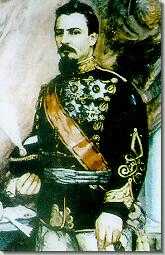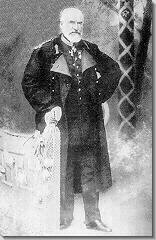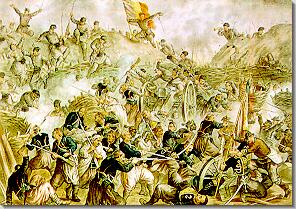NATIONAL REVIVAL
In
the 18th and early 19th centuries the feudal structures were
deeply eroded, the first capitalist enterprises emerged and at
the same time Romanian goods were attracted step by step into the
European circuit. The national idea, as everywhere else in
Europe, was becoming the soaring dream of intellectuals and the
underlying element in the plans for the future made by the
politicians.
The union of part of
the clergy in Transilvania with the Catholic Church (the Greek-
Catholics), achieved by the House of Hapsburg in 1699-1701,
played an important part in the emancipation of Transylvanian
Romanians. Their fight for equal rights with the other ethnic
groups (although the Romanians accounted for over 60% of the
principate’s population, they were still considered
“tolerated” in their own country) was begun by Bishop Inocentiu
Micu-Klein
and continued by the intellectuals grouped in the “Transylvanian
School”
movement.
These scholars proved
the Latinity of the Romanian language and people and, even more,
the fact that they had uninterruptedly been the autochthonous
population here. By virtue of this ancients, they demanded equal
rights with the other “nations” in Transilvania -
Hungarians, Szecklers and Saxons. The claims of the Romanians in
Transilvania were submitted to the Court of Vienna in the long
petition called Supplex Libellus Valachorum (1791), which did not receive any
answer.
The
Ottoman and Czarist troops occupied the Danube principalities
(1821), the sacrifices made by the Romanians brought about the
abolition of the Phanariot regime and native voivodes were again
appointed on the thrones of Moldova and Valahia.
The peace treaty of
1829 signed at Adrianople (today Edirne) ended the
Russian-Turkish conflict of 1828-1829; this treaty greatly
weakened the Ottoman suzerainty, but it increased Russia’s
“protectorate.” Now that trade was freed, Romanian
cereals began to penetrate European markets.
Under Pavel Kiseleff,
the commander of the Russian troops that occupied the two
Romanian principalities (1828-1834), quasi-identical Organic
Regulations
were introduced in Valahia (1831) and Moldova (1832); until 1859
these Regulations served as fundamental laws (constitutions) and
they contributed to the modernisation and homogenisation of the
social, economic, administrative and political structures that
had started in the preceding decades. Therefore, in the first
half of the 19th century, the Romanian principalities began to
distance themselves from the Oriental Ottoman world and tune into
the spiritual space of Western Europe. Ideas, currents, attitudes
from the West were more than welcome in the Romanian world, which
was undergoing an irreversible process of modernisation. Now the
awareness that all Romanians belong to the same nation was
generalised and the union into one single independent state
became the ideal of all Romanians.
Union
and Independence
The
winds of 1848 also blew over the Romanian principalities. They
brought to the centre-stage of politics several brilliant
intellectuals.
In
Moldova the unrest was quickly cracked down on, but in Valahia
the revolutionaries actually governed the country in
June-September 1848.
In Transilvania the
revolution was prolonged until as late as 1849. There, the
Hungarian leaders refused to take into account the claims of the
Romanians and they resolved to annex Transilvania to Hungary;
this led to a split of the revolutionary forces between the
Hungarians and the Romanians.
Although
the brutal intervention of the Ottoman, Czarist and Hapsburg
armies was successful in 1848-1849, the renewal tide favouring
democratic ideas spread everywhere in the next decade.
Russia
was defeated in the Crimean War (1853-1856) and this called into
question again the fragile European balance. Owing to their
strategic position at the mouth of the Danube, as this waterway
was becoming increasingly important to European communications,
the status of the Danube principalities became a European issue
at the peace Congress in Paris (February-March 1856).
Valahia and Moldova
were still under Ottoman suzerainty, but now they were placed
under the collective guarantee of the seven powers that signed
the Paris peace treaty; these powers decided then that local
assemblies be convened to decide on the future organisation of
the two principalities. The Treaty of Paris also stipulated: the
retrocession to Moldova of Southern Basarabia, which had been
annexed in 1812 by Russia; freedom of sailing on the Danube; the
establishment of the European Commission of the Danube; the
neutral status of the Black Sea.

Alexandru
Ioan Cuza (1859-1866),
Voivove of the United Principalities |
In
1857 the “Ad-hoc assemblies” convened in
Bucharest and Iasi under the provisions of the Paris
Peace Congress of 1856; all social categories
participated and these assemblies unanimously decided to
unite the two principalities into one single state.
French emperor
Napoleon III supported this, the Ottoman Empire and
Austria were against, so a new conference of the seven
protector powers was called in Paris (May-August 1858);
there, only a few of the Romanians’ claims were
approved. But the Romanians elected on January
5/17, 1859 in Moldova and on January 24/February 5, 1859
in Valahia Colonel Alexandru Ioan Cuza
as their unique prince, achieving de facto the union of
the two principalities. |
The Romanian nation
state took on January 24/February 5, 1862 the name of Romania
and settled its capital in Bucharest. Assisted by Mihail
Kogalniceanu,
his closest adviser, Alexandru Ioan Cuza initiated a reform
programme, which contributed to the modernisation of the Romanian
society and state structures: the law to secularise monastery
assets (1863), the land reform, providing for the liberation of
the peasants from the burden of feudal duties and the granting of
land to them (1864), the Penal Code law, the Civilian Code law
(1864), the education law, under which primary school became
tuitionfree and compulsory (1864), the establishment of
universities in Iasi (1860) and Bucharest (1864), a.o.

Carol
I, first King of Romania |
After
the abdication of Alexandru Ioan Cuza (1866), Carol
of Hohenzollern-Sigmaringen, a relative of the royal family of
Prussia, who was supported by Napoleon III and Bismark,
was proclaimed on May 10, 1866, following a plebiscite,
ruling prince of Romania, with the name of Carol
I.
The new
Constitution (inspired from the Belgian one of 1831),
which was promulgated in 1866 and was in use until 1923,
proclaimed Romania a constitutional monarchy.
In the next
decade the struggle of the Romanians to achieve full
state independence was part of the movements that took
place with other peoples in the south-east of Europe. |

Engraving of the Independence War period |
Within a
favourable international framework - in 1875 the Oriental
crisis broke out again and the Russo-Turkish war started
in April 1877 - Romania declared its full state
independence on May 9/21, 1877. The government decided, upon the
Russian request for assistance, to join the Russian
forces that were operative in Bulgaria. A Romanian army,
under the personal command of Prince Carol I, crossed the
Danube and participated in the siege of Pleven; the
result was the surrender of the Ottoman army led by Osman
Pasha (December 10, 1877). |
The
independence of Romania, as well as the union of Dobrudja with
Romania, were recognised in the Russian-Turkish peace treaty of
San Stefano (March 3, 1878). Upon the insistence of the great
powers, an international peace Congress was held in Berlin
(June-July 1878), which acknowledged and maintained the status
that Romania had proclaimed by herself more than a year before;
it also re-established, after a long period of Ottoman rule,
Romania’s rights over Dobrudja, which was re-united to
Romania. But at the same time Russia violated the convention
signed on April 4, 1877 and forced Romania to cede the Southern
Basarabia.
On March 14/26,
1881, Romania proclaimed itself a kingdom and Carol I of Hohenzollern-Sigmaringen was
crowned King of Romania.
After
gaining its independence, the Romania state was the place to
which the hopeful eyes of all Romanians who lived on the lands
still under foreign occupation turned. The Romanians in Bucovina
and in Basarabia were facing a systematic policy of assimilation
into the German and Russian worlds, respectively. Immigration of
foreign peoples was directed to their territory. The Romanian
enclaves in the Balkan Peninsula had increasing difficulties in
opposing the denationalisation tendencies. At the turn of the
20th century, the Romanians were a people with over 12 million
inhabitants, of whom almost half lived under foreign occupation.
At
the same time in Transilvania, the Romanians suffered the serious
consequences of the accord by which the Hungarian state was
re-established more than three centuries after its collapse and
the dual Austria-Hungary state was created (1867). Transylvania
lost the autonomous status it had under Austrian rule and it was
incorporated into Hungary. The legislation passed by the
government in Budapest, which proclaimed the existence of only
one nationality in Hungary - the Magyar one - sought to destroy
from the ethno-cultural point of view the other populations, by
forcing them to become Hungarian. This subjected the Romanian
population, along with other ethnic groups, to heavy ordeals.
At that time the National
Romanian Party
in Transylvania played an important role in asserting the
Romanian national identity; the party was reorganised in 1881 and
it became the standard bearer in the struggle to achieve
recognition of equal rights of the Romanian nation and it the
resistance against the denationalisation projects.
In
1892 the national struggle of the Romanians reached a climax
through The Memorandum Movement. The memorandum was drafted by the
leaders of the Romanians in Transylvania and it was sent to
Vienna to be submitted to emperor Franz Joseph I; it advised the
European public opinion of the Romanians’ claims and of the
intolerance shown by the government in Budapest regarding the
national issue.

This page hosted by

Get your own Free Home Page


